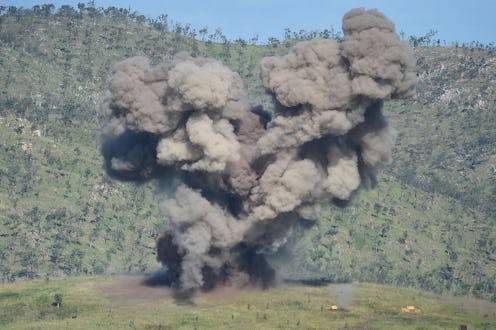News
Photos Of The MOAB Show Its Massive Size

The United States has just dropped the MOAB, its biggest non-nuclear bomb, in combat. On April 13, the Air Force announced that it dropped the GBU-43/B Massive Ordnance Air Blast, also known as the "MOAB" (an acronym that sparked the nickname "mother of all bombs") on a reported ISIS cave compound in an Afghanistan province near the Pakistan border. This 22,000-pound bomb packs a major punch — and some want to look at photos of the mother of all bombs to see what their country just dropped in Afghanistan.
In one photo from a 2003 testing in Florida, the MOAB is a pictured as a long, slender orange rocket with black stripes painted vertically down the sides. It has wings that are reminiscent of a plane. Another photo shows the bomb painted Army green, and provides a better view of the four-pronged tail rudder.
No matter what color it's painted, the MOAB has major effects not just on the direct vicinity of its fall, but in the area surrounding it as well. According to CNN, the outlet that originally broke the story, it remains unclear what damage the bomb has done, or if it reached any targets. In a statement, U.S. Afghanistan Forces described measures they took before dropping the MOAB:
US forces took every precaution to avoid civilian casualties with this strike. US Forces will continue offensive operations until ISIS-K is destroyed in Afghanistan.
Described as the country's strongest non-nuclear or "conventional" bomb, the MOAB is a GPS-led weapon built specifically for use as a "bunker buster" to reach underground bunkers such as the reported ISIS caves where the bomb was dropped Thursday. Despite its stated use, however, military tech writer David Hambling told the Daily Beast that the MOAB might have unintended consequences for the surrounding area:
It’s not the obvious choice of weapon to destroy a cave complex. It may generate a massive over-pressure causing lethal effects to some depth, but is much less obvious than weapons like the smaller thermobaric BLU-128, which is designed to take out tunnels and caves with blast.
In the Department of Defense's press release, however, Afghanistan commander Gen. John W. Nicholson described why the military believes the MOAB was the right choice:
As ISIS-K’s losses have mounted, they are using IEDs, bunkers and tunnels to thicken their defense. This is the right munition to reduce these obstacles and maintain the momentum of our offensive against ISIS-K.
It's too soon to assess what effect the MOAB had on ISIS or civilians in the surrounding areas, but it certainly made a splash as President Donald Trump's first major offensive on the jihadi group during his fledgling presidency.